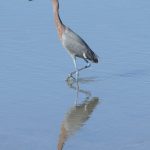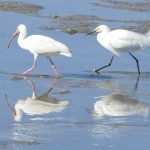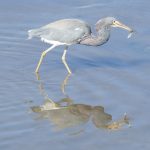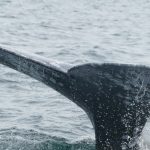Birding in Baja: two sorts of tails
By Eric Schroeder
When I first heard about the Golden Gate Bird Alliance trip to Southern Baja, I was tempted by the variety it offered—not only in the different sorts of habitat we’d be visiting there, but in the variety of bird species that would be present, and the opportunity to see California Gray Whales at their breeding grounds. Birds and whales—what could be better?
One of the additional pleasures of the trip was getting to bird with my close friends Bob and Margie Gomez, who traveled from Virginia to join our Bay Area group in Baja. The trip was led by Juan-Carlos Solis who was joined by his Mexican colleague, Gerardo Marron, a Baja specialist, and his cousin Daniel, who drove the van and was heroic with the logistics of managing our group. Gerardo was along to help us find some of the more difficult birds: Baja has only six endemic species, though there are many, many endemic subspecies, as Gerardo pointed out to us. Over the week we would see birds that looked very familiar yet just a bit different, including California Scrub Jays, Acorn Woodpeckers, and even California Towhees.
The first day we spent the morning birding around the estero next to the hotel in San Jose del Cabo. Our target species was the Belding’s Yellowthroat, formerly a yellowthroat subspecies but recently recognized as a new endemic. We got excellent (albeit quick) looks at this shy bird. Along the Estero San Jose we saw lots of familiar ducks and shorebirds and a large assortment of herons and egrets. Wheeling overhead were Magnificent Frigatebirds and Ospreys, with the latter occasionally swooping down to catch a fish. Afterwards we returned to the hotel grounds, where we watched Hooded Orioles and Cactus Wrens along with the most beautiful House Finches any of us had ever seen (a subspecies called “rubioso,” or “the reddest red,” as Gerardo put it).
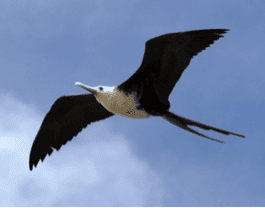

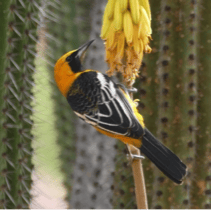
In the afternoon we headed north and inland and stopped at a piece of dry tropical forest. When we got out of the van, it was warm and still. Focusing in, we soon realized the place was teeming with birds—flycatchers, warblers, and vireos. But the vegetation was thick and these birds moved fast. Our guides were also fast, however, calling out the birds. I got excellent looks at a Black-throated Gray Warbler and a pair of Blue-grey Gnatcatchers. A flock of about ten Western Tanagers ate berries in a big tree, fueling themselves for their journey north. But the star of the afternoon was the Xantus Hummingbird: A beautiful male moved in and out of a nearby tree, giving us looks whenever it perched. This is a jewel of a bird—brilliant green on the head, with a bold white eye stripe and a long red bill tipped in black. And our second endemic of the day.
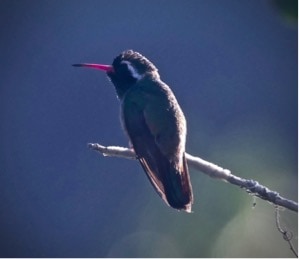
On Monday, we awoke in the dark to drive to a reserve located high in the southern Baja Sierra. As we got close, the road deteriorated: Towards the end it became a steep, rutted dirt track and at one point we all had to get out because we were afraid the vehicle might get bogged down in the small stream we had to cross. Shortly afterwards, Daniel parked the van and we prepared to hike up the mountain. We were told that it was a 1.9 mile hike, but what wasn’t made clear is that we’d be gaining almost 1500 feet of altitude in that distance. Our target for the day was the Baird’s Junco, a bird that lived in the forests high up in the mountains.
Near the base of the mountain we saw Lazuli Buntings, Pacific-coast and Ash-throated Flycatchers, and Blue-gray Gnatcatchers. As we climbed and the day warmed, we saw fewer species. And people slowed down. Nearing the top of our climb I saw a pair of Scott’s Orioles (life birds for me!) and a Cassin’s Vireo. When we finally made it to the top, most of our group collapsed in the shade. After some rest and very large sandwiches, we began scouring the area for the Baird’s Junco. Not only were the juncos absent, but the mountaintop seemed completely void of bird life.
Juan-Carlos persuaded us to continue for another few hundred meters—to one last spot where Gerardo had seen the juncos previously. Approaching the spot, Gerardo and Juan-Carlos got excited: They could hear the Baird’s Junco. I got a great look at one through a gap in some foliage. Unfortunately, not everyone was so lucky. But everyone was relieved that we had made it to the top—and even more relieved when we were at the bottom and back on the van.

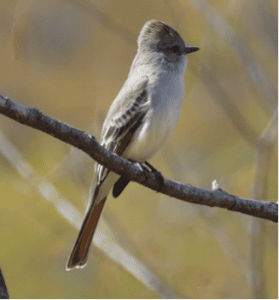
We spent Monday night in the original capital of California, La Paz, and on Tuesday morning we headed out to the mud flats. We were greeted there by a huge array of shorebirds (including American Avocets, American Oystercatchers, Marbled Godwits, Whimbrels, and Long-billed Curlews) and herons (Little Blue, Great Blue, Tricolor and both Black-crowned and Yellow-crowned Night-Herons), egrets (Great, Snowy, and Reddish), and cormorants (Double-crested, Brandt’s, and Neotropic). My birding friends who know me well know that I struggle with gulls, but I was pleased to find one I don’t see very often—the Laughing Gull—and even more pleased to see one that was new for me, the Yellow-footed Gull. Both of them were easy to identify.
The biggest treat of the mud flats was the large flock of Black Skimmers—so large at 75 birds that eBird wouldn’t allow me to enter that number without an explanation as to how it was that I saw so many of them (I’m still not sure how to answer that question, other to say that they flew in and I counted them all.)
After the mud flats, we made a visit to the nearby sewage treatment plant. (Non-birders are always a little queasy when I tell them I’m visiting a sewage treatment plant but birders know what hotspots these can be.) We saw two kinds of ibis—White and White-faced—and more ducks and coots. Although we didn’t pick up the bird we had come for—another look at the Belding’s Yellowthroat—we saw an equally colorful bird, the Vermillion Flycatcher. The day’s birding cumulated with a Phainopepla perched on a telephone wire outside our lunch stop, followed by a quick late afternoon stop about 200 kilometers down the road to observe four Harris’s Hawks perched alongside each other on cacti. They are the only species of raptor that hunts in a pack, and they were taking a break from their group pursuit of dinner.
On Wednesday and Thursday we went looking for something completely different—California Gray Whales. And we found them—lots of them. We were in Magdalena Bay where the Gray Whales come to calve, and although we didn’t see any newborns, we saw lots of adults, some of which swam right up to and under the boat. Amazing. And I’m pleased to say we did see birds. Included were three kinds of terns—Elegant, Royal, and Caspian—six kinds of gulls—Western, California, Laughing, Heerman’s, Ring-billed, and Yellow-footed—as well as Parasitic Jaegers and Black-vented Shearwaters.

We spent our final two nights of the trip in the beautiful village of Todos Santos. Juan-Carlos had a favorite birding spot on the edge of town that we visited on our first morning there. At daybreak, we saw a large raptor perched at the top of the tree. Juan-Carlos originally thought it was a Common Black Hawk, a relatively rare species. But he later determined it to be a Zone-tailed Hawk, which was rare enough that most of our group had never seen one.
One of our target birds was the Gray Thrasher, one of Baja’s six endemic species. We spotted a pair of them in the early morning light—on the edge of a rubbish heap. The scenery wasn’t too pretty but the birds were great. And that proved to be the theme of the morning—what could have been a lovely park on the edge of town was neglected and used as a dump, but proved to be home to a suite of beautiful birds. In addition to seeing warblers that are common in the Bay Area—Yellow-rumped and Orange-crowned—we saw the Nashville and MacGillivray’s. And other members of the morning’s colorful entourage included Gilded Flickers, Hooded and Scott’s Orioles, Northern Cardinals, and another appearance of the endemic Xantus’s Hummingbird.
Our last dinner in Todos Santos was spectacular (all of the food on the trip was first rate—wonderful seafood, including lots of ceviche, and guacamole with everything). But Juan-Carlos surprised us afterward by telling us we could sleep in the next day since we’d been getting up very early most mornings. I asked him whether he himself would be going out to look at birds.
“Do you want to go?” he asked.
“Of course, I replied.
My friends Bob and Margie Gomez who were sitting next to me said “We’re in!”
So the next morning we set off again at sunrise for the same spot we had birded the previous morning. I hadn’t gotten very good photos the first day and wanted a chance to try again. Fortunately, the Gray Thrasher was prepared to cooperate. He was not only near the same rubbish heap but this time he was also content to parade around in front of it, almost oblivious to our presence. The orioles also presented themselves for a photo opportunity as did the Xantus’s Hummingbird—a great last morning for the Baja trip.
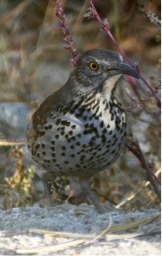

I saw a total of 102 species during the week, eight of which were life birds for me. And although I only saw one species of whale, there were too many of them to count!
Editor’s Note: Golden Gate Bird Alliance’s Travel Program will be offering this trip again next year from February 22 to 29, 2020. You can find more information about the trip on our website at https://goldengatebirdalliance.org/travel-with-ggas-2020/. If you’d like to sign up for the trip—or if you have questions—contact Eric Schroeder at ejschroeder@ucdavis.edu

